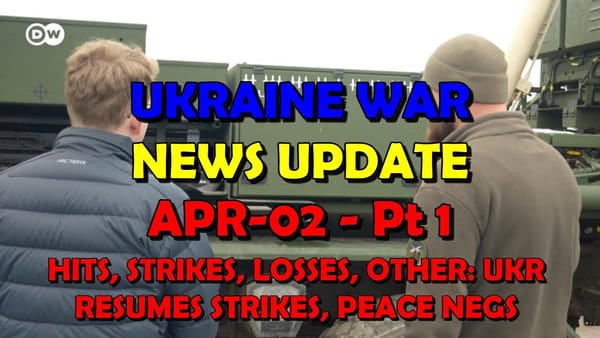Ukraine War BREAKING NEWS: Ukraine attacks into Belgorod?
🤖
This summary has been produced automatically by an AI Large Language Model (LLM) without any human intervention. Whilst every effort has been made to prompt the LLM to produce accurate output, there may be inconsistencies, inaccuracies or hallucinations!
Table of Contents 📖
` and `
🤖💭 AI Plan (pre task) - the AI's step by step thought process
My step-by-step thought process for completing this task was as follows:
Understand the Goal: The main goal is to summarise YouTube transcripts from ATP Geopolitics in British English, broken down into topics and outputted in XML format. This is for "ATP Distilled" project, focusing on extracting key insights.
Initial Reading & Familiarisation: I read through the entire prompt carefully, paying attention to all instructions, rules, and examples for each task. I noted the required XML tags and formats, the importance of British English and Ukrainian spellings, and the specific categories of ATP videos. I also noted the common misspellings and names provided as guidance.
Task Breakdown & Planning: I mentally broke down the task into the six sub-tasks (Title/Date/Part, Topic Titles, Timestamps, Summaries, Quote, Queries). For each task, I reviewed the specific rules and examples.
Task 1 (Title, Date, Part):
Title: I identified the core title "Ukraine War BREAKING NEWS: Ukraine attacks into Belgorod?" by removing the date and part information.
Date: I extracted "20250321" and converted it to "21/03/2025".
Part: There was no part in this title, so I left it empty.
XML: I wrapped these in the correct XML tags: ``, ``, ``.
- Task 2 (Topic Titles):
- First Pass - Topic Identification: I read through the transcript, sentence by sentence, identifying shifts in topic. I looked for keywords, changes in subject matter (e.g., from Musk's China plans to his Russia connections). I aimed for granular topics. I immediately identified the "Hello Team" intro and anticipated a "Wrap up" at the end.
- Second Pass - Title Formulation: For each identified topic section, I formulated a concise, specific, and quantified topic title. I focused on what the topic was about and tried to be as informative as possible in a short title. For example, the initial section is about Musk and China war plans, so "Musk to receive briefing on US war plans for China" became the first main topic title after "Hello Team". I continued this process for the rest of the transcript, breaking it down into logical sections. I aimed for more topics rather than fewer, to ensure granularity.
- Ukrainian Spellings & British English: I kept in mind to use Ukrainian spellings and write in British English as I formulated the topic titles.
- Numbering & XML: I numbered the topics sequentially and wrapped each title in `
` and `
` tags.
- Task 3 (Topic Timestamps):
- Timestamp Extraction: I went back through the transcript and, for each topic identified in Task 2, I noted the start timestamp of the first sentence of the topic and the end timestamp of the last sentence of the topic. I made sure the timestamps corresponded to the transcript provided.
- Format & XML: I formatted the timestamps as MM:SS (or HH:MM:SS if needed, but in this case, all were MM:SS). I then wrapped each timestamp range in `
` and ` ` tags, ensuring the `id` matched the corresponding `topictitle` id. - Gaps Check: After noting all timestamps, I quickly scanned through to make sure there were no large gaps in the time coverage and that the timestamps flowed logically.
- Task 4 (Topic Summaries):
- Detailed Reading & Summarisation: For each topic, I re-read the corresponding section of the transcript more carefully. I focused on extracting the key information, Jonathan's analysis, opinions, and any important details.
- Bullet Points & Markdown: I used bullet points to structure the summaries for readability. I considered using bold or italics for emphasis, but decided against it to keep it concise as per the instruction to use it sparingly (though markdown is indicated as acceptable).
- Context & Insights: I ensured I included enough context within each summary so it made sense. I tried to capture Jonathan's insights and reasoning, as requested. I noted that Jonathan was reading from articles, so made sure to reflect that he was reporting on news from the New York Times, Mother Jones, Fiona Hill etc.
- British English & Ukrainian Spellings: I wrote the summaries in British English and double-checked spellings, including Ukrainian place names and corrected any obvious transcript errors (like "Hegseff" to "Hegseth" and "oligoderaphasca" which was likely meant to be "Oleg Deripaska").
- XML: I wrapped each summary in `` and `
Return to top⤴️` tags, matching the `id` to the topic number.
- Task 5 (Quote):
- Quote Selection: I reviewed the summaries and thought about the transcript as a whole. I looked for a quote that was insightful, impactful, or representative of Jonathan's perspective on the situation. I chose the quote "Honestly, be woke. What I mean by that is be awake to what the hell is going on because it is happening under our very eyes here." as it encapsulates Jonathan's concern and call to attention about Musk's influence.
- Formatting & XML: I ensured the quote was properly punctuated and free of transcript errors. I wrapped it in `` tags.
- Task 6 (Queries):
- Review & Reflection: I reviewed all the tasks and considered if there were any parts of the transcript or instructions I didn't understand. In this case, the transcript was fairly clear and the instructions were detailed.
- Queries XML: I entered "Everything was understood." within `` tags as I didn't have any specific queries.
🤖❓ AI Debrief (post task) - anything the AI didn't understand
` and `
- Final XML Assembly & Verification:
- Structure Check: I assembled all the XML elements in the correct order as specified in the "OVERALL XML STRUCTURE" example.
- Tag Verification: I did a final read-through of the entire XML output, double-checking every opening and closing tag to ensure they were correctly matched and spelled, and that attributes were correctly used (like `id=X`). I specifically checked for common errors like typos in tag names (e.g., ``).
- Content Review: I gave it one last quick read to catch any typos or formatting inconsistencies in the summaries and titles.



